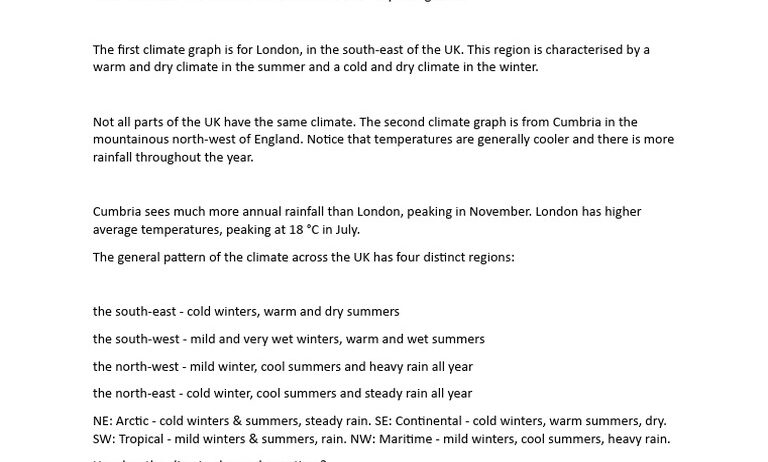The climate in the United Kingdom is characterized by its temperate maritime conditions, which result in a relatively moderate range of temperatures and frequent precipitation. The diverse weather patterns are a reflection of the eponymous system of atmospheric influences that ebb and flow, creating a vibrant tapestry of climatic experiences throughout the year. This essay aims to delve into the distinctive features of the UK’s climate, including fog, rain, and the charms of the changing seasons.
One cannot discuss the climate of the UK without acknowledging its propensity for rainfall. Rain is often perceived as the quintessential characteristic of British weather, and rightly so. The country experiences precipitation on a near-daily basis, with the western regions, such as Wales and Ireland, receiving the highest amounts. This rainfall is not merely a nuisance; it plays a pivotal role in supporting the rich biodiversity that exists in the UK. The abundance of moisture nourishes the lush greenery, while also replenishing rivers and lakes vital for both ecosystems and human activity.
Rainfall in the UK varies significantly by location. The western part of the country, thanks to its proximity to the Atlantic Ocean, receives an average annual precipitation ranging from 1,500 to over 3,000 millimeters. Conversely, areas in the southeast, such as London, tend to receive about 600 to 700 millimeters annually. This disparity is largely due to orographic lift, whereby moisture-laden winds ascend over the hills and mountains of Wales and northern England, leading to enhanced rainfall in those regions. The east side of the country, shielded from these influences, experiences a drier climate overall.
Within this overarching narrative of rainfall, mist and fog frequently stalk the landscape, particularly during the autumn and winter months. The image of a fog-laden morning, cloaking the verdant hills and ancient stone edifices, is a hallmark of British scenery. The fog arises when moist air cools, causing water vapor to condense into tiny droplets suspended in the air, resulting in reduced visibility. Certain areas, like London and the rural Thames Valley, are notorious for their fog. Historically, fogs were so dense that they influenced urban policies, evidencing the extent of environmental impacts on human life.
Fog has a way of adding an ethereal quality to the UK’s landscape. The play of light filters through the haze, creating a picturesque and almost mystical atmosphere that has inspired countless artists and writers. It contributes to the allure of visiting historical sites, as the shrouded ruins of castles and cathedrals seem to emerge from the mists of time itself. This enchanting feature of the UK’s climate cultivates a sense of wonder but also serves as a reminder of the region’s vulnerability to climatic fluctuations and the broader implications of climate change.
As we transition through the calendar, we encounter the charm of the UK’s seasons. Each season presents its own narrative, woven with vivid colors and climatic contrasts. Spring bursts forth with an exuberance reminiscent of renewal. The days elongate, and temperatures gradually warm, inviting an explosion of blossoms and verdant growth. This season serves as a crucial time for wildlife; bees awaken from their hibernation, busying themselves among the flowers, which are critical for pollination and the overall health of ecosystems.
Summer, often regarded as the most pleasant season, can be deceptive. The UK does experience warm weather, with temperatures sometimes exceeding 30°C, particularly during heatwaves. However, due to the maritime influence, summer weather can also be erratic and marked by unanticipated showers. Nevertheless, the combination of longer days and brighter weather fosters spirited outdoor activities. Festivals, picnics, and community events thrive, as the populace embraces the fleeting glimpses of sunshine and warmth.
As summer wanes, autumn graces the landscape with its fiery hues. The leaves of trees metamorphose into breathtaking shades of amber, crimson, and gold, creating a stunning tapestry against the often-grey sky. This transition is marked by a gradual drop in temperatures and an uptick in rainfall, providing a critical period for crops as they mature for harvest. The damp atmosphere often favors the growth of fungi, resulting in the mushroom foraging activities that enrich both culinary and cultural experiences.
Winter blankets the UK in a serene stillness, but the presence of snow is sporadic. While the north may experience snow-covered vistas, the south typically sees milder conditions. The cold months signify a time for hibernation among many species, while the landscape is often painted in monochromatic shades of grey and white. The long nights provide opportunities for stargazing, as clearer skies prevail, offering an enchanting glimpse of the cosmos that many have come to appreciate.
The interplay of fog, rain, and the cyclical seasons of the UK constitutes a dynamic climate that shapes both the landscape and the lives of its inhabitants. This climate significantly influences agricultural practices, biodiversity, and cultural traditions. Awareness and appreciation of these nuances foster a deeper understanding of the environment we inhabit. Navigating this delicate balance will be key in fostering resilience against the challenges posed by climate change, ensuring that the enchantment of the UK’s climate endures for generations to come.








